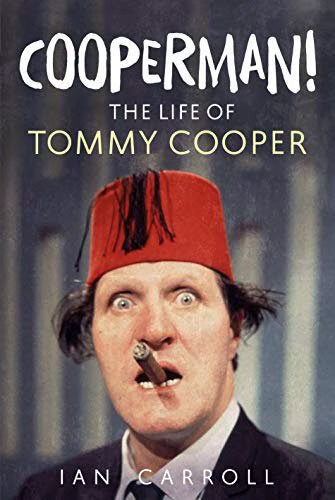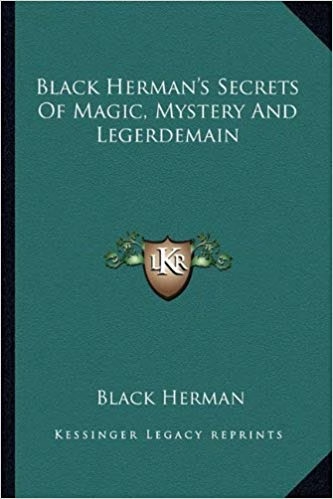When the spotlight fades
A curtain raiser on magicians’ final acts
Our Illustrious Cast
Many magicians of the last two centuries have been shrouded in mystery, made famous by their self-promotion, or even infamous for their illusions. Few magicians performed dangerous publicity stunts.
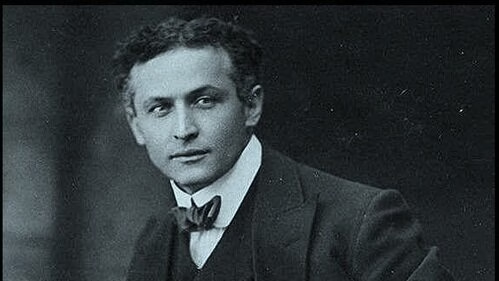
Our Illustrious Cast
Many magicians of the last two centuries have been shrouded in mystery, made famous by their self-promotion, or even infamous for their illusions. Few magicians performed dangerous publicity stunts.
TableofContents
Think of a dangerous occupation. No one thinks of the magician. The “US president” occupation doesn’t make it onto the “fatal occupational injuries per 100,000 workers” chart even though 9% were killed in office. The same for magicians (they can’t get on the list).
For 5,000 years, magic has charmed the public; for 5,000 years, the public has been intrigued by danger.
When an audience responds strongly to a magic trick, magicians call it a “killer” effect. For the 18 illusionists listed below, the “killer effect” wasn’t a figure of speech.
The reasons for a tragedy never seem like good reasons. These magicians took great risks for a spectacle, to please spectators. The performers suffered permanent failure when an otherwise thrilling magic trick went wrong.
Magicians
Tommy Cooper
When he was a child, the other kids laughed at Tommy Cooper. He tried his hand at magic.
One time during a performance, Tommy mucked up a trick and the audience burst into laughter.
In the next show, Tommy mucked up that same trick, but this time it was on purpose. Same laughter. Soon, Tommy engineered his entire act to be screw-ups. The audience loved it.
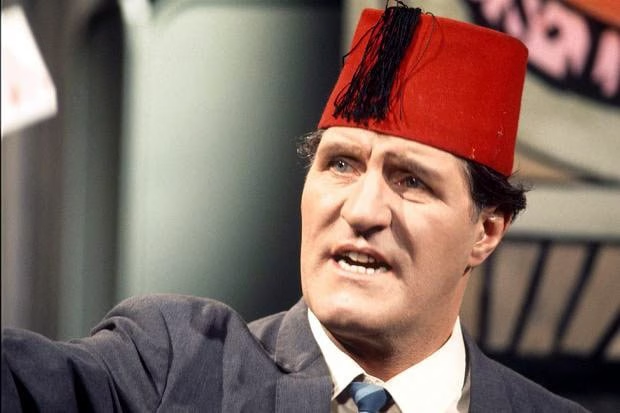
Tommy Cooper was an English comedian and magician. His act consisted of screwing up tricks and harvesting laughs from his incompetence.
It wasn’t unusual for him to fall over and lay about on the stage. That’s why, during his slapstick routine on Live from Her Majesty’s at Her Majesty’s Theatre in London, no one realized something was amiss when Cooper keeled over on stage and died from a massive heart attack.
He had a heart attack and the audience believed it was part of the act. That’s why they laughed. Had the audience realized it was not part of the act and responded more quickly, Tommy Cooper would not have died that day.
Audience members laughed as Tommy lay dying before them. The broadcast cut to a commercial and Tommy Cooper was pulled off stage. After several attempts to revive him failed, Tommy was transported to a hospital where he was proclaimed dead.
Tommy died while performing to an audience laughing as he lay dying on stage.
Joe Burrus
Joseph Burrus was handcuffed, sealed in a plastic coffin, set in a grave seven feet under, and buried alive beneath seven tons of dirt and wet cement.
What could go wrong?
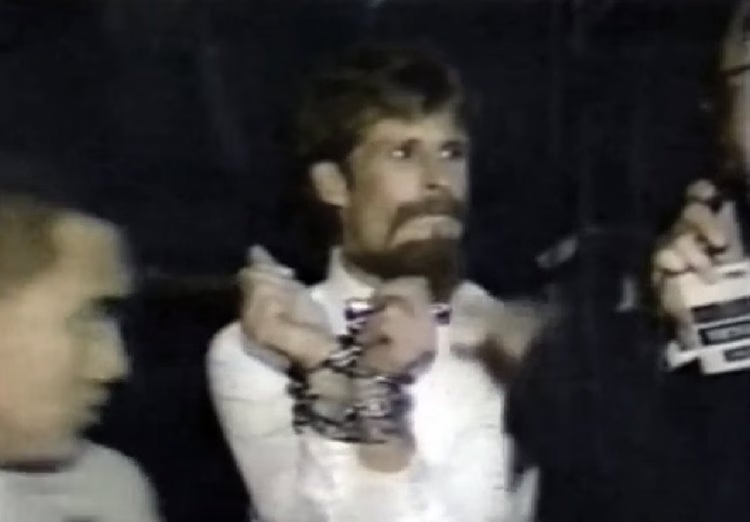
Miraculously, no one could convince Joseph that it was impossible, and that he would need some sort of illusion to come out of this trick still breathing.
It’s easy to blame the magician for being foolhardy, but remember that pleasing the public is the magician’s aspiration, and if the public wants to see danger, that’s what the earnest magician will offer.
Before the stunt, a Louisville newscaster covering the story mentioned that cement below dries quicker than the top layer; that he would still have all his work ahead of him even if he didn’t get crushed, that he would still have to burrow through several feet of dirt before attempting to break above the thickening cement—all on a constrained supply of oxygen.
Joe Burrus was feeling confident that Halloween day.
After all, he had in 1989 performed the stunt successfully.
But in 1989, only dirt covered him. In 1990, the dirt above him didn’t have the same pizzazz. Joseph decided to add cement to the mix.
Tragically, he had forgot to factor in the fact that wet cement weighs more than dirt.
Joseph Burrus had tried to duplicate Harry Houdini’s feat of being buried alive and he failed. In the same moment his plastic coffin was crushed, his dream was crushed.
The dream of outdoing Houdini.
On the eve of Halloween, 1990, and the anniversary of Houdini’s demise, 32 year old Joseph was crushed alive in his plastic coffin while his own children watched.
Whoever said, “Tricks are for kids,” must have missed the Burrus magic show when Joseph Burrus got crushed to death in front of his own kids.
Charles Rowan Magician – Karr The Mysterious
The magician seeks to entertain his audience. How dangerous can that be? In the event of failure, he can learn from his errors.
If he lives to learn from them.
During an escape attempt in 1930, this top Chicago magician died in front of a crowd of onlookers by a car driving into him while he was still working on escaping the straight jacket.
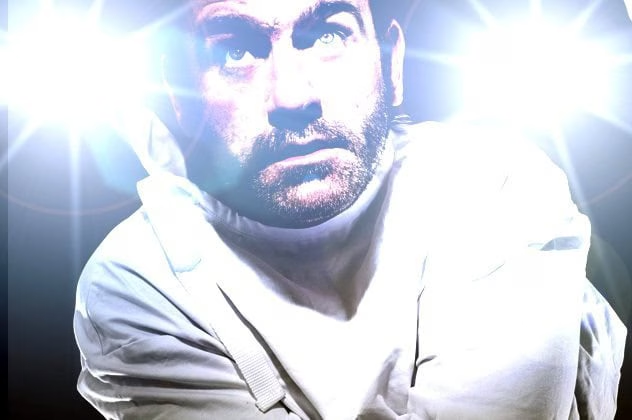
Charlie Rowen, professionally known as, “Karr the Magician” had made a name for himself escaping from straight jackets and jumping into piles of broken glass and staples (like ya do).
To Charlie these were staples in his act.
In 1930, as a Chicago magician, Charlie had been performing as usual. He was trying a feat in which he would be strapped in a straight jacket while a man in a car drove directly at him.
Whatever, no big deal, work, work, work, another day at the office.
The car approached from two football fields away, 45 miles per hour. That gave Charlie Karr about 10 seconds to extricate himself from the jacket and dodge the oncoming car.
But he wasn’t fast enough.
Before a crowd of popcorn-eating spectators (half of them children), Mr. Karr was unable to escape in time and he was hit by the car, dismembering him.
Whoever said, “Tricks are for kids,” wasn’t there when Karr The Mysterious was getting ripped apart by a car.
Black Herman
Stage name Black Herman, famous for being buried alive for three days, Benjamin Rucker’s pet effect was to perform his show after being exhumed from his three-day slumber in a tomb.
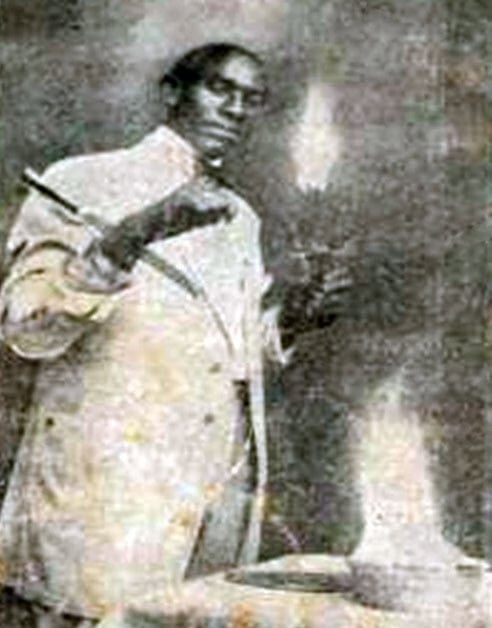
Towards the end of this promotional magic show in Louisville, KY in April 1934, Benjamin collapsed on stage having suffered a heart attack.
The spectators thought this was part of Black Herman’s show and refused to believe the performer was really dead.
Benjamin’s promoters exploited this disbelief, selling tickets to Benjamin’s funeral so that the attendees could see whether Benjamin was dead.
Vivian Hensley
Magic should be left to the professionals—especially when it comes to death-defying stunts.
Just look at what happened to Vivian Hensley.
The story of Australian dentist Vivian Hensley is hard to swallow. He was a 43 year old man who dabbled in magic.
As Fate would have it, this dentist ultimately suffered a painful death from something he put in his own mouth.
Dr. Hensley was practicing for his son his own signature magic trick that he creatively called “Swallowing The Rusty Razor Blade.”
On a hot summer day in 1938, instead of sleeving the razor blade (slipping it up his sleeve), he made a fatal error and dropped the razor blade down his throat.
Despite going to the hospital (driven by his wife), undergoing X-rays and surgery, Dr. Hensley died four days later.
Janaka Basnayake
Janaka Basnayake was a 24 year old from Sri Lanka. Janaka had a dream to exceed the world record for longest duration buried alive.
I guess we all have that dream.

In the Spring of 2012, Janaka managed to persuade his family to bury him in a hole 10 feet deep, and then shovel dirt and wood on top of him. He had been buried for over seven hours before being digged out.
When they found him he was dead.
If anyone reading this was inspired to set a record by being buried alive, you should be aware that Guinness Book of World Records does not acknowledge being buried alive as a legitimate feat on the grounds that it is too risky and they don’t want to give people a reason to attempt it.
Genesta
An American magician named Royden Raison de la Genesta, or simply Genesta, favored the water barrel escape as his own pet.
It’s a simple plot where the performer is locked inside a barrel filled with water, milk, or glue, and try to get out before drowning.
Fun stuff.
I bet YOU wish YOU could escape from a locked barrel filled with milk.

Genesta took his signature trick from Houdini, who had performed it in 1908.
The idea was simple yet attractive to audiences—Genesta locked himself in a milk can or barrel filled with water.
Fail to escape a straight jacket and you risk humiliation.
Fail to escape the milk can and you risk breathing milk for the rest of your short life.
Sadly, in St Louis Missouri magic show, one fateful and fatal day in 1930, the magician failed to make his escape.
When stage hands ascertained something was wrong, the curtain fell. A medic rushed onstage. Assistants pulled Genesta from the can.
He was unconscious but revived and rushed to the hospital, where he died after telling the doctor that, in more than 10 years of performing the trick, he had never failed before.
In 1930, there was one problem.
Reportedly, the milk can Genesta used during his final performance was dented. This limited the space he had to contort his body to make a timely escape, and may have contributed to his demise.
Genesta had done this before, but in 1930 during his performance, he found himself inside a can of milk which had been dented during its transport to the event, leaving him constrained in even less space than usual.
This single dent precluded him from moving his body in the necessary way to escape.
He failed to extricate himself and he drowned in milk. His death led to other magicians and escape artists performing it, some of them using Elmer’s glue instead of milk, since his death made the trick more appealing to the public and drew larger crowds.
Rayburn Hooper
In 1984, though his wife May begged him not to, 23 year old magician Rayburn Hooper was rehearsing an escape trick that he intended to show later that afternoon for his Winona Lake church Sunday school assembly. Hooper would try to escape after being shackled and sunk in a lake.

But Jeff Rayburn Hooper never made it to the performance.
While rehearsing the stunt, Hooper handcuffed his wrists and leaped into Winona Lake, Fort Wayne, Indiana. As best he could in handcuffs, he swam out hundreds of feet from the bank.
Fortunately, Hooper liberated himself from the shackles, then he broke above the wake and shouted to May, his lovely assistant and wife. Unfortunately, on account of the high winds against him, May could not hear him, and he could not swim against the winds to the shore.
Though the water was only 6 feet deep, the 23 year old magician drowned.
The Great Lafayette
Harry Houdini admired Sigmund Neuberger, aka The Great Lafayette—a German magician who was the most sought after magician of his era and a light that ignited the passions of generations of magicians following him.
Houdini knew that Sigmund loved animals, and so Harry gave The Great Lafayette a gift — a terrier named Beauty.
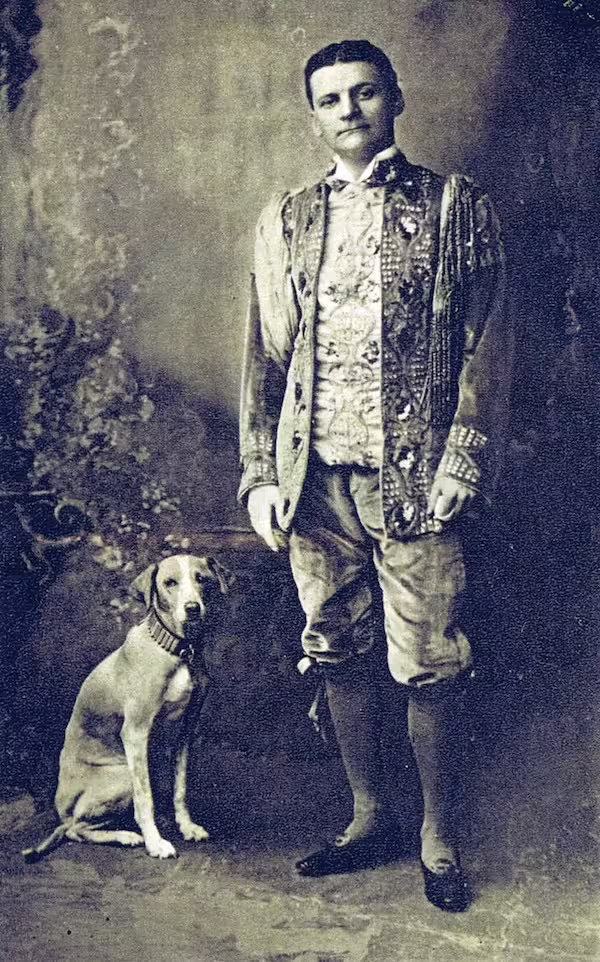
Sigmund loved Beauty so much that he pampered the terrier with its own diamond-studded collar, five-course meals, and everything a dog could wish for.
Just days prior to the opening of Sigmund’s new show in Edinburgh, Beauty died.
Lafayette had made a deal with the city council that he would allow what they wanted—at his death his own body to be buried in the city on the condition that they would bury Beauty in the Piershill Cemetery.
In May of 1911, the grand opening of The Great Lafayette’s show, a fire broke out while he was performing his pet effect, “The Lion’s Bride.”
The Great Lafayette did escape from the auditorium and the building, but he dashed back into the flames to save his horse that was part of his magic show. He died in the flames.
Sigmund’s body was laid to rest beside his beloved Beauty.
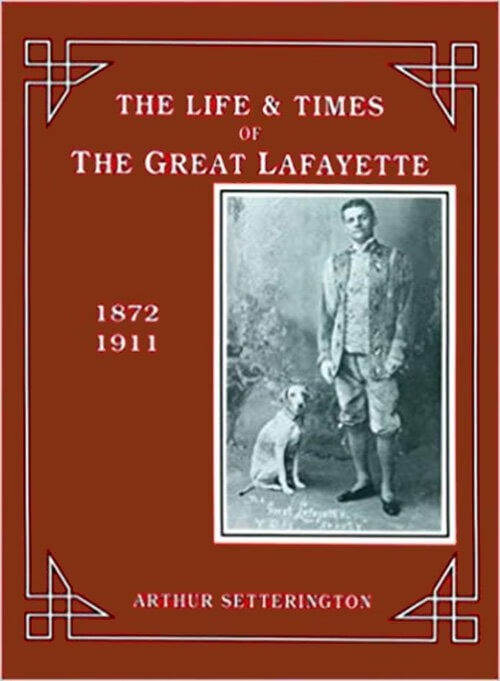
Washington Irving Bishop
Washington Irving Bishop’s mother was a fraudulent medium (is there any other kind?).
He grew up (as all children do) and eventually ended up working for a spiritualist fortune Teller and mentalist. Later in life he decided to expose them and all their tricks.
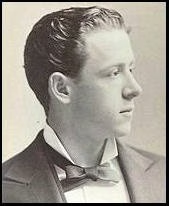
He saw the futility of exposing psychics.
Many believers won’t change their mind even if they are educated about the chicanery, and some don’t change their mind even if the psychic is caught red-handed—this has happened many times and the “psychic” amazingly never loses his flock.
This happens to magicians more often than you might expect, even after the magician explains to the spectator the method of a trick.
So Bishop decommissioned himself of his mission to expose psychics and he resigned himself to became a mentalist in his own right, even inventing the now popular blindfold drive (where the mentalist drives a car blindfolded).
You’d think this is hypocrisy if you weren’t already aware of the difference between a psychic and a mentalist.
“Mentalist” is the broader term and encompasses any trained performer who apparently achieves extraordinary mental feats.
A “psychic” is a mentalist who pretends to read minds and see the past and future.
A “medium” is someone who pretends to talk to ghosts—and may even be convinced of his or her own delusions, despite using artifice and ruses known to magicians.
Long before 2001 when UK mentalist Derren Brown made it fashionable, Bishop clearly explained to his spectators that his powers were purely natural and not psychic.
His staple—later adopted by The Amazing Kreskin (who incidentally is an asshole who fleeces old ladies of their pension nowadays) was contact mind reading, aka “muscle reading.”
The performer when doing muscle reading either holds the hand of a participant or has the participant place a hand on the performer’s shoulder.
The performer talks (asks questions, makes statements), and without the participant orally conveying any messages, and without intending to, at times even trying to block the mentalist, Bishop succeeded in gaining private knowledge in the recesses of the participant’s mind.
Of course this is a natural skill that looks like a supernatural gift, but anyone who has the will and the time to practice will discover it is possible.
After some practice you grow sensitive to the subtle muscular dancing in their hands and you can conduct adequate readings. Do it enough and your readings will often be startling.

If you’ve lost your Netflix password and would like to try it, have your friend hide a nickel in the corner of a room while you’re not in the room. Come back and grasp your friend’s cheek or wrist and start meandering.
As you do this, you don’t need to speak. Just turn your awareness—as much of it as you can—to your hand on your friend’s wrist. Now meander. You will feel it, a slight reluctance to follow or a readiness to follow.
Once you’ve guessed the correct corner five out of five times, have your friend hide the biscuit (yes, it can be a nickel, a biscuit, a thimble, or anything that remains in place; i.e., not a hamster) anywhere in the room—nota corner. Rinse and repeat.
During performances Bishop sometimes would collapse at any moment. He suffered from catalepsy and he kept a note on his person explaining that he should not be pronounced dead until 48 hours had passed.
On the 12th of May, 1888, during an exhibition at the New York City Lamb Club, Bishop collapsed on stage. In this case Bishop was alive but fell into a cataleptic coma.
A short while later he awaked and tried to finish the show; however, he sunk down into unconsciousness. He was brought off stage and soon pronounced dead. The note had fallen out of his pocket and was later found on the stage floor.
Then things get a little hazy.
Because Bishop had catalepsy, many people did think that he was still alive. Bishop’s mother wholeheartedly believed that the autopsy was what finally killed him.
The doctors, like scientists, were specialists in one important arena—and that wasn’t trickery. They were intent on studying Bishop’s brain since they wanted to learn whether his brain was peculiar, affording him his mind powers.
Just as scientists have been fooled for years by and humiliated by mentalists (look up Steve Shaw who now goes by the name Banachek), doctors are human, too.
The Bullet Catch
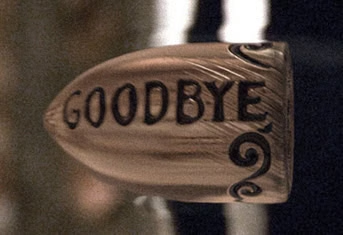
In 1364, the earliest firearm was developed. By the 1500s, pistols and rifles had gained popularity.
Is it possible for a human being to catch a speeding bullet in his mouth?
Common sense be damned. For centuries, magicians have been convincing audiences that this is possible.
The bullet catch stunt may be a legitimate feat or it may be a trick. If you dismiss it as a mere trick, you will still need to explain the dozen magicians that have died performing it.
The demonstration of the bullet catch proceeds as follows: an audience member inspects a bullet, marks it for identification, and loads it into the firearm. A volunteer or assistant shoots the gun at the magician’s mouthhole.
But there’s a (bullet) catch.
The performer catches the bullet with his teeth or in a goblet held in his mouth and shows the marked bullet to the crowd for confirmation.
In recent versions of the trick (David Blaine or Penn and Teller), a plate of glass is set between the performer and the gun to dramatically show the trajectory of the bullet.
There have been fully 15 deaths associated with this stunt.
I bet you didn’t even know there were 15 magicians who performed it.
Let’s look at seven magicians who would become unfortunate targets of the bullet catch.
Chung Ling Soo
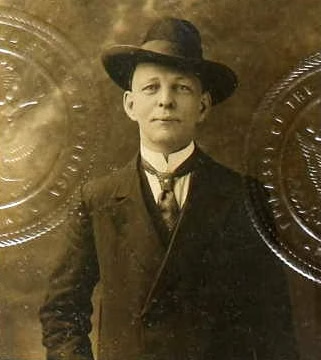
The American magician William Ellsworth Robinson had adopted the persona of a Chinese magician and was best known by his stage name, “Chung Ling Soo.”
Even in interviews he always had used an interpreter to maintain this theatrical facade.
He was one of the most famous magicians of his era, and he appears as a character in the 2006 blockbuster movie The Prestige, starring Hugh Jackman, Christian Bale, Michael Caine, and directed by Christopher Nolan.
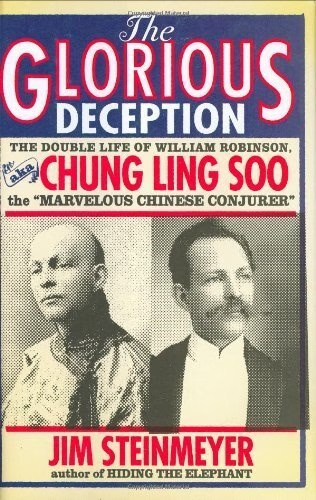
For his bullet catch, William used a two-chambered rifle. He put the live round into one barrel which he displayed to the audience, and the other chamber held a paper cartridge.
During a routine performance on in March 1918, William Robinson shot himself for real.
As most workplace accidents happen by accident and by carelessness, this was no exception.
Chung Ling Soo had not cleaned the rifle after the previous performance, so gunpowder had accumulated in the barrel. In this routine performance the paper cartridge lit that build up of gun powder, and the explosion of the powder launched the real bullet waiting in the second barrel into William’s chest.
Until March 23rd, William had performed using made-up Chinese to add authenticity of his show. As the bullet tore through William’s lung, he, for the first time on stage, spoke in English, in his own voice, and his own real accent.
William’s last words were, “Lower the curtain.”
Magician kills wife – Madame DeLinsky
In the 1800s, a well-known husband/wife duo toured Europe. They were the DeLinskys.
Inone of their sensational feats Madame DeLinsky faced a firing squad and walked away unscathed having caught all the bullets.
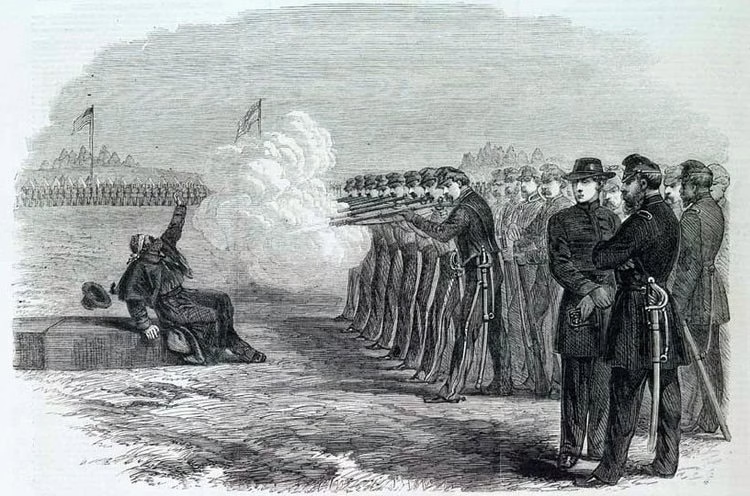
Spoiler alert—to tell the story it’s necessary to reveal the method. The duo achieved this by instructing the soldiers to bite away the bullet and load instead a blank.
Shots were heard but no bullets were shot. Madam DeLinsky then showed the onlookers her handful of six bullets she had been concealing on her person.
In November 1820, and pregnant, Madame DeLinsky and her husband were performing the bullet catch in Germany for Prince Shwarznberg-Sonderhausen and the rest of the royal family.
Being on stage, one of the riflemen evidently felt nervous being on stage, and returned to his trained fashion of loading the firearm—he loaded a live round instead of the blank.
Reportedly, some of the royal family fainted when this rifleman fired and shot dead Madam DeLinsky.
Her husband went into shock having lost his wife and unborn child, never performed again, and ultimately went mad.
Arnold Buck
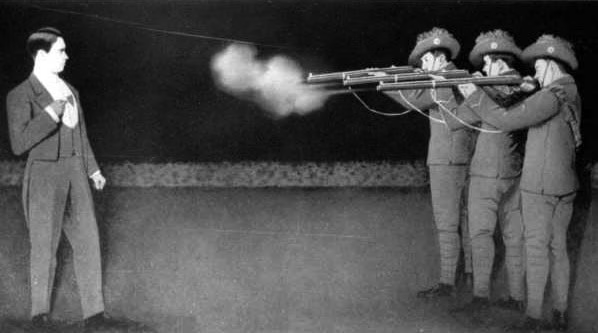
Ever wonder where the word “buckshot” came from?
The magician and the pickpocket are together the second oldest profession as the magic show aids the pickpocket’s goal.
Throughout history and as long as the magician has been showcasing his magic show, there has been the skeptical, insecure, or simply immature spectator who hoped to muck up the magic show and cause the magician failure.
Sadly, Arnie Buck selected one such troublemaker as his volunteer to put the bullet into the firearm.
The bullet was a blank.
However, the volunteer dropped a handful of nails into the barrel. Then he shot the gun at magician Arnie Buck.
This sharp grapeshot was what killed Arnie Buck.
Professor Adam Epstein
He who lives by the wand dies by the wand.
The magic wand is a deadly weapon in the right hands—just ask Adam Epstein.
But for most, magic wands aren’t especially dangerous; however, if you live half your life performing magic (and you happen to be mortal) then one day you’re going to die, and odds are you’ll be doing magic. Your death and your magic converge in the same moment.
Adam Epstein died by his own magic wand.
Literally.
To the magician, the magic wand is not simply a decoration.
Magicians use it for its functionality.
One can do miracles with it that can’t be achieved without it. If this doesn’t make sense,consider that it’s a lot easier to conceal an object in an apparently empty hand if that hand is holding an instrument than it is to conceal an object in a hand ostensibly holding nothing and dangling at one’s side.
The magic wand is ideal for making coins vanish.
One should always remember the 3rd rule of using your magic wand: you should never use the wand for ramming ammunition down the butt of a gun prior to a performance of catching the bullet (or at any time). This is what Adam Epstein did at his St Louis Missouri magic show.
In what would be his farewell St Louis performance, his wand broke. One of its shooting shards pierced his head and killed him.
The Black Wizard of The West
In 1922 The Black Wizard attempted the bullet catch in Cincinnati on stage without any prior rehearsal of his magic show in Cincinnati. That is a grave error whether you’re performing the bullet catch or the Miser’s Dream (a trick that hasn’t killed any magicians).
To his mind, his idea couldn’t fail.
He had purchased some wax bullets and recruited his wife as his lovely assistant, not recognizing the resentment she harbored towards him.
That resentment inspired her to switch the wax bullets for live bullets.
She shot him dead in front of a stunned audience.
Ralf Bialla

In 1975 Ralf Bialla was regarded as an eccentric German magician and billed “The Living Target.” He had exhibited his bullet catch literally thousands of times before, a feat he attributed in part to his steel teeth.
Wearing steel gloves, he would form a funnel with his hands before the bullet was shot through three panes of glass into his mouth. Eventually, as a result of catching so many bullets, Ralf began to suffer from circulation problems causing him to pass out.
After a show in 1975, he went for a hike in the mountains.
Standing on the edge of a cliff and beholding the beauty of the mountains before him, the steel-toothed magician passed out, falling to his death.
Theodore Annemann
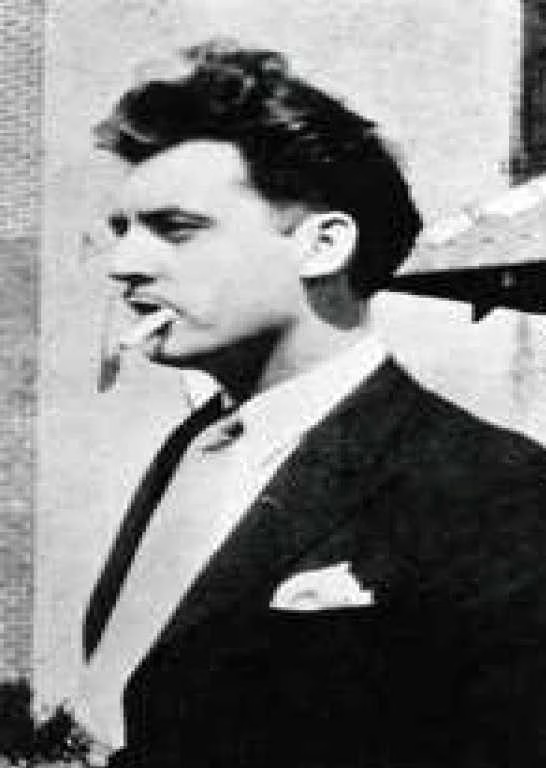
Theodore Annemann was a tragic figure and a brilliant contributor to the art of mentalism. Ask any serious mentalist his favorite author on mentalism and you’ll likely hear it’s Ted Annemann, who penned “the bible of mentalism,” Practical Mental Magic.
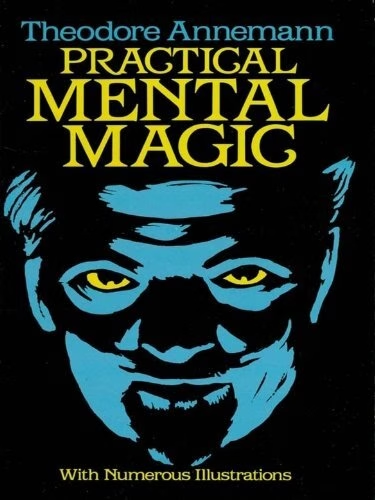
Annemann was obsessed with knowing the minds of other people.
But the hardest trick of all is learning to control one’s own mind.
Theodore had been battling personal demons during his final days, depressed during this time, perhaps by the forthcoming show of his famous bullet catch.
Or perhaps by the sobering realization that the bullet catch was his first sold-out show.
Theodore went to such pains to make sure he would off himself: his rig of the bag over his head, the gas pip set-up to the bag.
Like his carefully thought-out and exacting mentalism tricks, the outcome of this last trick was inevitable — suicide. There was no way the expert could miss.
He longed for that final curtain.
Harry Houdini
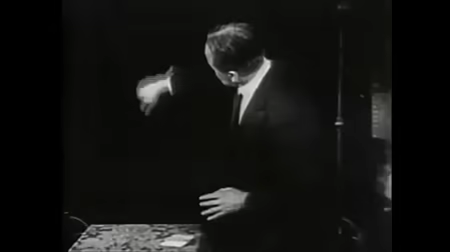
Houdini – how did he die?
In 1926, Harry Houdini’s death at age 52 was less dramatic than his life, but his inclusion here is necessary since he died on stage and his death by magic was the direct result of one of his tricks.
Though few of us—none of us?—can name an actor, singer, or athlete from 94 years ago, we all know the name Harry Houdini.
Harry Houdini, born Erich Weiss, before becoming famous for escapology — escaping from shackles, straight-jackets, prisons, etc., had billed himself as the King of Kards (playing cards).
He performed card tricks and was competent with a deck of cards, but ultimately discovered the public’s thirst for his death-defying stunts freeing himself.

When he was younger, he had done a trick where a strong audience member would come up on stage, typically a football player, and would punch Harry with full force in the stomach as Harry Houdini withstood the blow. It would not faze Houdini — that was the stunt.
One day when he was leafing through his mail, one of his students, Gordon Whitehead, asked him whether he could still do that trick. Still looking at his mail, Harry nodded his head and said that he could still do it if given time to brace himself.
The student then punched him in the stomach four times.
For days Harry could not sleep and was in constant pain, but continued to perform his show.
He finally saw a doctor who diagnosed him with acute appendicitis and Harry was urged to go to the hospital for surgery.
Harry Houdini insisted on performing his event that night.
By the middle of the third act, Harry had been off-cue, needed help to do some of the maneuvers on stage, and his fever had risen to 104 degrees.
His last words were, “I’m tired of fighting.”
He died October 31st 1926. His funeral was held November 4th, and the Society to this day holds its Broken Wand ceremony every year at Houdini’s grave site.
Exit stage left: a final salute to fallen magicians
Under the dimming limelight, we end our exploration of these 18 extraordinary lives that were abruptly snuffed out in their pursuit of awe and wonder.
Each one embarked on a journey of illusion and enchantment, and their stories serve as sobering reminders of the risks embedded in the magician’s path.
Each act met with a tragic end, but their names and legacies will forever be a part of magic’s riveting chronicles. The final bow was unexpected, but the echo will forever reverberate in the hushed whispers of theater halls around the world.
As we pull the curtains closed and the audience disperses, we salute these fallen magicians, honoring their dedication to an art form that continues to mystify and captivate.
Jon Finch is the top magician on zoom and entertains at corporate and social events throughout the world.


